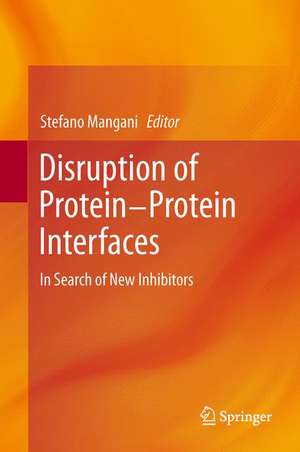Disruption of Protein-Protein Interfaces: In Search of New Inhibitors
Editat de Stefano Manganien Limba Engleză Hardback – 9 iul 2013
| Toate formatele și edițiile | Preț | Express |
|---|---|---|
| Paperback (1) | 634.32 lei 6-8 săpt. | |
| Springer Berlin, Heidelberg – 4 aug 2015 | 634.32 lei 6-8 săpt. | |
| Hardback (1) | 639.25 lei 6-8 săpt. | |
| Springer Berlin, Heidelberg – 9 iul 2013 | 639.25 lei 6-8 săpt. |
Preț: 639.25 lei
Preț vechi: 752.06 lei
-15% Nou
Puncte Express: 959
Preț estimativ în valută:
122.32€ • 128.05$ • 101.21£
122.32€ • 128.05$ • 101.21£
Carte tipărită la comandă
Livrare economică 08-22 aprilie
Preluare comenzi: 021 569.72.76
Specificații
ISBN-13: 9783642379987
ISBN-10: 3642379982
Pagini: 200
Ilustrații: VII, 161 p.
Dimensiuni: 155 x 235 x 17 mm
Greutate: 0.39 kg
Ediția:2013
Editura: Springer Berlin, Heidelberg
Colecția Springer
Locul publicării:Berlin, Heidelberg, Germany
ISBN-10: 3642379982
Pagini: 200
Ilustrații: VII, 161 p.
Dimensiuni: 155 x 235 x 17 mm
Greutate: 0.39 kg
Ediția:2013
Editura: Springer Berlin, Heidelberg
Colecția Springer
Locul publicării:Berlin, Heidelberg, Germany
Public țintă
ResearchCuprins
Drug discovery by targeting protein-protein interactions.- Protein-Protein Interaction Inhibitors: case studies on small molecules and natural compounds.- Disrupting Protein-Protein Interfaces using GRID Molecular Interaction Fields.- NMR as a tool to target protein-protein interactions.- Protein-protein interactions in the solid state The troubles of crystallizing of protein- protein complexes.- Fluorescence observables and enzyme kinetics in the investigation of PPI modulation by small molecules Detection, mechanistic insight, functional consequences.
Notă biografică
Stefano Mangani has been professor of general and inorganic chemistry at the University of Siena since 1994. His main field of research is bioinorganic chemistry and structural biology and he currently focuses on the role of metal ions in metalloenzyme catalysis and in metalloproteins, with particular emphasis on the chemistry occurring at the metal sites as revealed by accurate structural data. Professor Mangani is regularly invited to speak at international conferences and seminars. He is the author of over 140 publications in international scientific journals and book series and has also written a general and inorganic university textbook and a web-course on general chemistry.
Textul de pe ultima copertă
"Disruption of Protein-Protein Interfaces" reviews the latest developments and future perspectives in drug discovery at protein-protein interfaces, as well as including details of experimental and computational tools to tackle the subject, and highlighting the contribution of the Italian research community to the field. Evidence shows that blocking or modulating protein-protein interactions might lead to the development of useful new drugs. Consequently, in recent years great effort has been dedicated to unveiling the molecular details of protein-protein interfaces by structural techniques e.g. X-ray diffraction, NMR spectroscopy. This book, written and edited by leaders in the field, provides examples from the literature of successes and failures to develop drug-like molecules effective in interacting at protein-protein interfaces.
Caracteristici
Provides an overview of the present state and future perspectives of drug discovery at protein-protein interfaces Gives details of both computational and experimental tools used in the field Gives positive examples of drug-like molecules effective in interacting at protein-protein interfaces Includes supplementary material: sn.pub/extras












